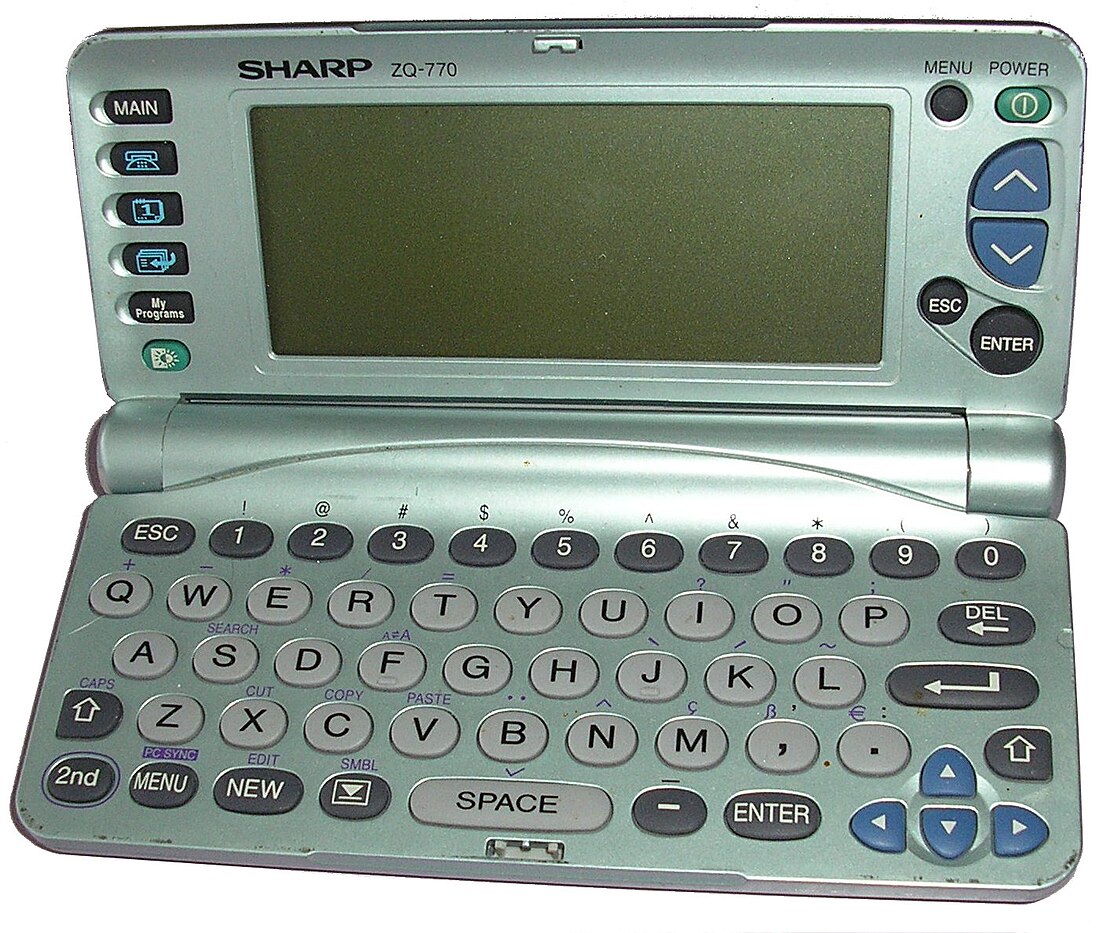Top Qs
Timeline
Chat
Perspective
Electronic organizer
Calculator-size computer From Wikipedia, the free encyclopedia
Remove ads
An electronic organizer (or electric organizer) is a small calculator-sized computer, often with a built-in diary application and other functions such as an address book and calendar, replacing paper-based personal organizers. Typically, it has a small alphanumeric keypad and an LCD screen of one, two, or three lines.
This article needs additional citations for verification. (January 2020) |



They were very popular especially with businessmen during the 1990s, but because of the advent of personal digital assistants and palmtop PCs in the 1990s, as well as smartphones in the 2010s, all of which have a larger set of features, electronic organizers are mostly seen today for research purposes. One of the leading research topics being the study of how electronics can help people with mental disabilities use this type of equipment to aid their daily life.[1] Electronic organizers have more recently been used to support people with Alzheimer's disease to have a visual representation of a schedule.[2]
Remove ads
History
The electronic diary or organizer was first patented by Indian businessman Satyanarayan Pitroda in 1975.[3]
Casio digital diary
Casio digital diaries were produced by Casio in the early and mid 1990s, but have since been entirely superseded by mobile phones and PDAs.
Other electronic organizers
While Casio was a major role player in the field of electronic organizers there were many different ideas, patent requests, and manufacturers of electronic organizers.[4] Rolodex, widely known for their index card holders in the 1980s, Sharp Electronics, mostly known for their printers and audio visual equipment, and lastly Royal electronics were all large contributors to the electronic organizer in its heyday.
Features
- Telephone directory
- Schedule keeper: Keep track of appointments.
- Memo function: Store text data such as price lists, airplane schedules, and more.
- To do list: Keep track of daily tasks, checking off items as you complete them.
- World time: Find out the current time in virtually any location on the globe.
- Secret memory area: The secret memory area keeps personal data private. Once a password is registered, data is locked away until the password is used to access the secret area.
- Alarm
- Metric conversion function: Conversion between metric units and another measurement unit.
- Currency conversion function
- Game: Some machines included a game such as Poker or Blackjack.
Modern alternative
Nowadays, electronic organizers have replaced various applications installed on smartphones or PCs. Appointment management software is divided into two categories: desktop applications and web systems (also known as "software as a service" or cloud systems). Online booking is booking through the Internet in an interactive mode. Centralized Reservation Systems (CRS) are computerized systems used to store and retrieve information, as well as to conduct transactions related to air travel, hotel accommodations, car rentals, and other activities. Originally developed and operated by airlines, CRS were later expanded for use by travel agencies and Global Distribution Systems (GDS) to book and sell tickets for multiple airlines. Most airlines have transferred their CRS to companies providing GDS services,[5] which also provide consumer access through internet gateways. Appointment scheduling software or meeting planning tools enable companies and professionals to manage appointments and bookings. This type of software is also known as appointment booking software and online booking software. This solution is designed not only for the convenience of users and clients but also for businesses. For example, comprehensive salon scheduling software ensures efficient time management and smooth daily operations.[6] As appointment booking software has developed, developers have focused on integrating it with other business tools and automating various processes. Integration with Customer Relationship Management (CRM) systems, email marketing platforms, and payment gateways has become common, allowing companies to effectively manage appointment bookings and optimize related processes. Automation features such as online booking and reminders have further enhanced efficiency and quality of customer service. The rise in popularity of smartphones and mobile applications in the late 2000s to early 2010s stimulated the development of mobile apps for appointment booking. These apps provided users with access to schedules at any time, as well as the ability to book, reschedule, or cancel appointments from mobile devices. Additionally, cloud solutions emerged, enabling users to securely store appointment data in the cloud and access it from multiple devices. Artificial Intelligence (AI) and machine learning algorithms have been used to optimize scheduling, minimize conflicts, and improve meeting routing. Virtual assistants and chatbots have also been integrated into appointment scheduling software, providing automated client interactions and self-service booking. Furthermore, the COVID-19 pandemic in 2020 and subsequent social distancing measures prompted the development of new features to support remote meetings and virtual consultations.[7][8] Integration of videoconferencing and telemedicine capabilities has become an integral component of many modern appointment scheduling solutions.
Remove ads
See also
References
External links
Wikiwand - on
Seamless Wikipedia browsing. On steroids.
Remove ads
